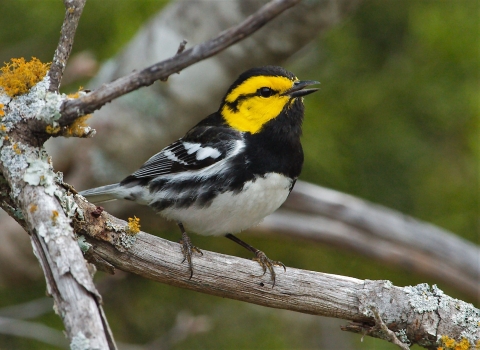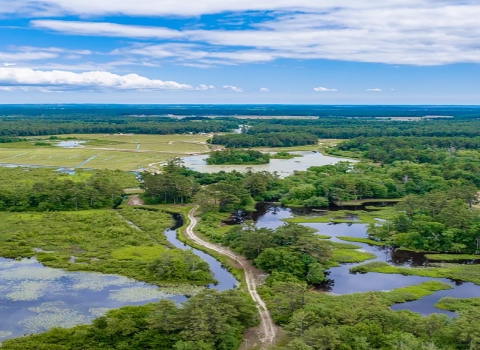WASHINGTON —The Department of the Interior today announced a more than $120 million investment from the Inflation Reduction Act to rebuild and restore units of the National Wildlife Refuge System and partnering State Wildlife Management Areas that have been affected by adverse weather events. The investment prioritizes projects that promote coastal resilience and climate adaptation, address invasive species invasive species
An invasive species is any plant or animal that has spread or been introduced into a new area where they are, or could, cause harm to the environment, economy, or human, animal, or plant health. Their unwelcome presence can destroy ecosystems and cost millions of dollars.
Learn more about invasive species threats, and provide for additional data collection needed to support successful natural resource resilience.
The Inflation Reduction Act is enabling the Department of the Interior to play a leading role in the transition to a clean energy economy, advancing key habitat restoration, land resilience and water projects and securing environmental justice for historically disadvantaged communities.
“Communities across the country continue to face the devastating impacts of weather events made even more extreme due to climate change climate change
Climate change includes both global warming driven by human-induced emissions of greenhouse gases and the resulting large-scale shifts in weather patterns. Though there have been previous periods of climatic change, since the mid-20th century humans have had an unprecedented impact on Earth's climate system and caused change on a global scale.
Learn more about climate change . The Inflation Reduction Act is a historic and transformational investment towards achieving President Biden’s ambitious goals to help American families and tackle the climate crisis,” said Secretary Deb Haaland. “These projects will increase the resiliency of habitats and infrastructure to withstand severe and unanticipated weather events, furthering our work to restore America’s natural infrastructure through nature-based solutions.”
“The Inflation Reduction Act supports the work of the U.S. Fish and Wildlife Service and its conservation partners, and helps local, state and Tribal communities tackle the climate crisis while advancing endangered species priorities and environmental justice,” said Service Director Martha Williams. “These investments will advance climate resilience, support habitat and critically important breeding areas and support the recovery of endangered species.”
Today’s announcement follows the release of the Department’s restoration and resilience framework a plan to leverage historic investments in climate and conservation to achieve landscape-level outcomes across the nation. Through President Biden’s Bipartisan Infrastructure Law Bipartisan Infrastructure Law
The Bipartisan Infrastructure Law (BIL) is a once-in-a-generation investment in the nation’s infrastructure and economic competitiveness. We were directly appropriated $455 million over five years in BIL funds for programs related to the President’s America the Beautiful initiative.
Learn more about Bipartisan Infrastructure Law and the Inflation Reduction Act, the Department is implementing a more than $2 billion downpayment to restore our nation’s lands and waters. The framework lays out an initial set of keystone initiatives to guide historic investments from both laws, which are focused on addressing the climate and biodiversity crises, advancing co-stewardship and equity, furthering locally-led, collaborative strategies and focusing landscape-scale restoration work on areas where the Department has an opportunity have a transformational impact at scale.
The funding announced today advances the goals of the framework as well as the Department’s grasslands keystone initiative through investments in prairie potholes and bison management. More than $7 million of the funding will be dedicated to advancing bison and grasslands restoration, consistent with a new Secretary’s Order. Examples of investments include funding for new fencing at Rocky Mountain Arsenal National Wildlife Refuge in Colorado to allow the refuge’s bison herd to graze on an additional 4,500 acres; improving the quality of over 2,000 acres of grasslands; and ensuring consistent access to water for the herd in the face of worsening drought conditions. Another project includes funding to Rio Mora National Wildlife Refuge in New Mexico to support a co-stewardship effort with the Pueblo of Pojoaque for management and expansion of the Pueblo’s bison herd on the refuge.
The U.S. Fish and Wildlife Service will work with state partners to complete geographically diverse, large-scale projects that are mutually beneficial for these conservation areas, including projects that benefit historically underserved communities and Tribal interests.
The list of projects include:
- $27.25 million for the Albemarle-Pamlico Sound restoration in North Carolina.
- $25 million to create a landscape conservation approach for a climate resilient Northern Forest in the Midwest and Northeastern regions of the United States.
- $23 million for landscape conservation and restoration in the Prairie Pothole Region (Iowa, Minnesota, Montana, North Dakota and South Dakota).
- $20 million for nature-based resiliency in the Lower Mississippi River Valley, encompassing parts of Arkansas, Louisiana, Mississippi and Tennessee.
- $10 million for nature-based resiliency and restoration in the Upper Mississippi and Illinois River to include parts of Illinois, Iowa, Minnesota, Missouri and Wisconsin.
- $7.5 million for bison management and grasslands habitat improvements across several Service refuges.
- $7 million for nature-based solutions to support the endangered Yaqui fish species on San Bernardino National Wildlife Refuge in Arizona.
- $1 million for the acquisition of LiDAR Data over National Wildlife Refuge System lands in partnership with the 3D Elevation Program.
The announcement also comes as the Endangered Species Act (ESA) turns 50 years old in 2023. Throughout the year, the Department is celebrating the importance of the ESA in preventing the extinction of imperiled species, promoting the recovery of wildlife and conserving the habitats upon which they depend. Each of the projects funded plays a significant role in protecting habitats and species at risk of extinction.
Get more information about the Service’s Inflation Reduction Act-related efforts.
The U.S. Fish and Wildlife Service works with others to conserve, protect and enhance fish, wildlife, plants and their habitats for the continuing benefit of the American people. For more information, visit www.fws.gov and connect with us on social media: Facebook, Instagram, Twitter, LinkedIn, Flickr and YouTube.



